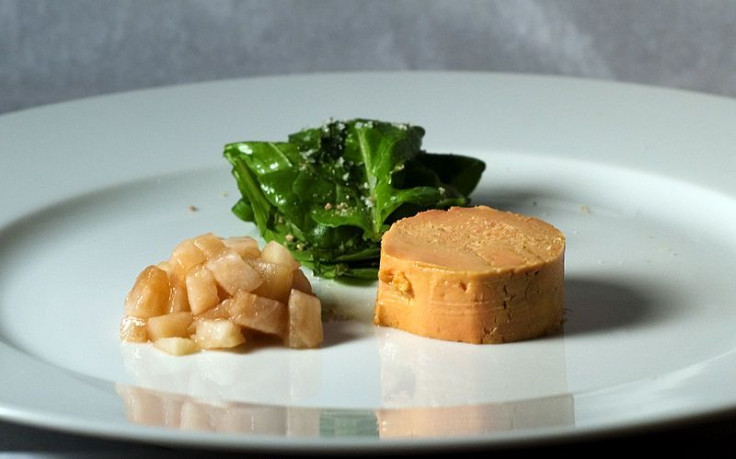Foie Gras: Low-Carb Fatty Liver Poses Deadly Health Risks; Duck Dish Banned In Parts Of The US

Consumption of the once-dubbed "heart-healthy" French delicacy foie gras is now known to be a risk factor for developing secondary systemic amyloidosis — the buildup of abnormal proteins in tissues and organs. The Gascony region of France accounts for approximately 80 percent of the world's production of goose and duck fat liver (foie gras) says OneKind.org, a United Kingdom-based animal protection charity that works to end animal cruelty. The fatty liver food was previously thought to aid the heart based on a 10-year epidemiological study conducted by Dr. Serge Renaud, director of research at the National Institute of Health and Medical Research in Lyons, FR. The study found that inhabitants of the Gascony region had a diet that was heavy in saturated fat compared to any other group of people in the world yet had a low number of heart-related deaths — and concluded that this was due to foie gras consumption. The World Health Organization's (WHO) Multinational Monitoring of Trends and Determinants in cardiovascular disease (MONICA), reports that out of 100,000 middle-aged French men, an estimated 145 die of heart attacks a year but only 80 die of heart-related deaths in the Gascony region.
While these statistics suggest that foie gras can be a healthful meat in moderation, the health risks of the duck dish outweigh the pros. In a paper from the Institute of Neurobiology in France, published in the journal Proceedings of the National Academy of Sciences (PNAS) researchers examined the amyloidogenic potential of foie gras. Microscopic infectious protein fibers found in the bird dish can trigger and further accelerate amyloid-related diseases in individuals who may be predisposed to a series of medical conditions such as inflammatory diseases.
The bottom lone? Foie gras is unhealthy for humans despite its low-carb content. About 85 percent of its calories are from fat — a 2-ounce serving contains 25 grams of fat and 85 milligrams of cholesterol says Self. In addition, the process of how foie gras is produced violates animal rights and is a dangerous health hazard for not only the birds but humans as well.
Production of Foie Gras
The heavy, fat-rich French delicacy is rich in amyloids because of how it is produced. Ducks or geese are gavage-based feed meaning they are force feed approximately two to three weeks before slaughter, says People For the Ethical Treatment Of Animals (PETA). The duck or goose is confined to a cage and fed a diet high in protein and high in starch to promote rapid growth of the liver. The liver often becomes enlarged because of the carbohydrate-rich diet and can put the bird at risk for hepatic steatosis — the excessive amounts of fats inside liver cells. The excessive amount of amyloid build up leading to amyloid deposits is due to the force-feeding of ducks and geese.
Human Diseases Triggered By Foie Gras
Consuming foie gras will most likely not cause a disease in someone to whom it is not genetically predisposed. People who are prone to inflammatory diseases are at higher risk of developing secondary amyloidosis if they regularly consume the bird dish. Since a high concentration of amyloid is found in force-fed birds, it is best for those who have Alzheimer's, rheumatoid arthritis, type 2 diabetes or other amyloid-related diseases to avoid foie gras consumption. The buildup of amyloids can happen in a single organ or throughout the body as it can affect any organ or tissue says the University of Maryland Medical Center.
Symptoms of Amyloidosis
The signs and symptoms of this disease vary depending on which organ or organs of the body it has affected. Mayo Clinic suggests to pay close attention if you experience:
- Swelling of your ankles and legs
- Weakness
- Significant weight loss
- Shortness of breath
- Numbness or tingling in your hands or feet
- Diarrhea or constipation
- Feeling full quickly
- Severe fatigue
- An enlarged tongue (macroglossia)
- Skin changes, such as thickening or easy bruising
- Purplish patches (purpura) around the eyes
- An irregular heartbeat
- Difficulty swallowing
- Protein in the urine (detected by urine tests)
U.S. Ban On Foie Gras
The process to generate a fatty liver in ducks and geese is done through force-feeding. This process is deemed cruel and inhumane to animals due to the enlarged size of their liver that can impair the functioning of the birds' liver and scar their esophagus. The Animal Legal Defense Fund filed a legal petition with the USDA stating that foie gras should have a warning label that reads "NOTICE: Foie gras products are derived from diseased birds." While the USDA has not banned the consumption of this French delicacy nor has opted to put a warning label, parts of the U.S. have decided to take matters into their own hands and ban this dish.
California
Before the State of California banned the force feeding of birds to enlarge their livers and sale of the products that were produced this way in 2012, the San Diego City Council passed a law in 2008 to stand up against this form of animal cruelty.
Illnois - Chicago
The foie gras ban in the city of Chicago lasted from 2006 to 2008. The reason for the intial ban was because the method in which the duck dish was produced was a clear form of animal cruelty believed Alderman Joe Moore who proposed the ban. Chicago Mayor Richard M. Daley disagreed with the ban and therefore objected it. The ban was therefore repealed by the City Council in 2008.
Published by Medicaldaily.com



























